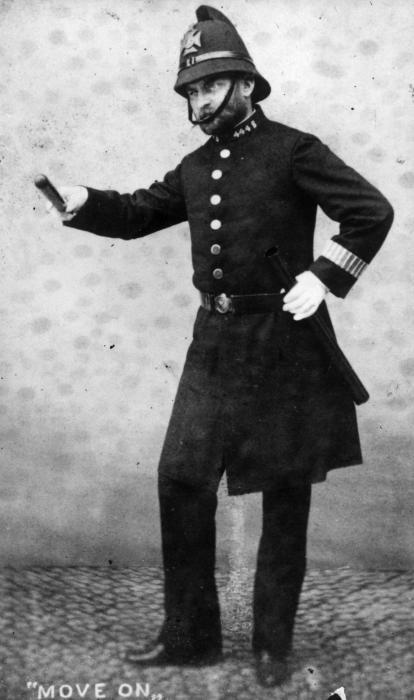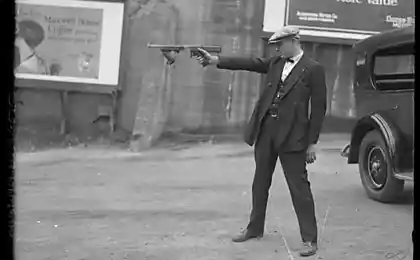2628
The history of the British police
The word "police" - of Latin origin and means "civil administration".
The forerunner of the current police force is considered to be the police of London, founded in the late 20-ies of the XIX century, and its main task is put crime prevention.

At 6 pm on Tuesday, September 29, 1829, the first Metropolitan Police constables step up patrol service.
At that time, the head office of the police was placed at number four in Whitehall, five local offices - in central London.
Police wearing dark blue jackets and trousers, and black leather hat with a crown.
High leather collar jacket designed to protect from strangulation.
So typical outfit was designed to constables as much different from the soldiers.
Every cop has a rattle to call for help, and his only weapon served a short stick.

and the moment of its inception, the London police numbered 895 constables, 88 sergeants, 20 inspectors and superintendents of eight. At the same time, civilian police staff consisted of only five clerks and district activities covered only the city center within a radius of 7 miles.
First constables virtually received no training. They just showed pre-patrol route. They were provided with printed instructions of the Police Commissioner.
The instructions stated that the first duty of a constable is the prevention of crime. It also said that law enforcement officers are obliged to be polite to people of all ranks and classes, to be seasoned and does not abuse its power.
Then-Interior Minister Robert Peel took seven years to convince Parliament of the need for such a unit. London in those years was the city of Regina and Oliver Twist. However, the decision to establish the police were not dictated by fear of crime, and to civil unrest.
The UK government was afraid of the revolution. At the beginning of the XIX century revolt in London and other cities suppressed troops. In 1815 the London criminals for three days full control over the area of the West End, the city plundered and burned the house of nobles, including the homes of ministers.
In 1819, eleven people were killed and hundreds injured when the cavalry attacked the largest political rally in Manchester. This event forced the Duke of Wellington's call for the immediate creation of civilian police forces to maintain public order.

The first commissioners, which at the beginning of July 1829 chose Robert Peel, was 47-year-old Lieutenant Colonel Charles Roan and 33-year-old lawyer, Richard Mayne. Commissioners had in his possession less than three months to map out work plans to recruit the right people and find accommodation for them.
Roan, relying on his army experience, developed the structure of the police force, which has been preserved for the most part, to the present day. He also introduced the basic system and patrol.

Salary both commissioners in 1829 was very modest - 800 pounds a year. Moreover Roan, which Peel saw as a senior, had a free apartment at Scotland Yard.
The name "Scotland Yard" was given to the police office, in reality, is located at 4 Whitehall Place, for the reason that its rear side, he came out on the street with the same name Scotland Yard.
In 1890, the police moved to a new headquarters in a beautiful building on the Thames, which became known to the whole world under the name of New Scotland Yard.

Dials the police recruits were to be under 35, be in good physical health, be an increase of at least 1, 67 m, to be able to read and write, to have a good character.
First half of constables worked the night shift with a nine in the evening until six in the morning.
The rest of the work for the remaining fifteen hours.
Constable, who carried out the arrest during the night, had to remain in service as long as the prisoner did not appear in court.
Weekly day of rest was not.
Pension system - too. Constables were paid three shillings a day, which is about half the salary of a skilled craftsman in London.
Not surprisingly, many constables were dismissed in the first years of drunkenness, theft, extortion of money from prisoners.
Other shortly left for better paying jobs.

Life was no easy first constables.
They are often attacked.
Between police and soldiers from the barracks in London often clashed initiated, oddly enough, by the commanders of the army, fearful of the downsizing of the army in peacetime after the establishment of the new police force.
Even firefighters attacked the police when they were caught on the spot of the fire extinguishing fire, as it is deprived of their salaries.
The first attempts of police to control the chaotic traffic of London put it in an even more precarious position.
Most cab drivers knocked policemen ran the traffic, - and such actions encourages employers.
Newspapers almost daily published false and exaggerated reports about the behavior of the police.
Police were given the nickname "peeler" or "Bobby" - "after" Minister Robert Peel.
Radical newspapers called the police "bloody gang Peel" - the name is quite reflect the mood of criminals and the London poor. Wealthy citizens: merchants, bankers, and a new generation of industrialists and hated police because she did not agree to return the stolen property without some questions to the owners.

The police themselves had to appear in court on business. When a sergeant arrested a man for beating his wife, the magistrate convicted the husband and imposed a small fine. My husband pushed against a sergeant charged with assault. The magistrate upheld the prosecution and the police officer was sentenced to two months in prison. However, he was released from prison after the expiration of this period, because he could not pay court costs. Often magistrates simply closed the case for those who were charged with assaulting a police officer. Thus, the leader of the gang, prokolovshy constable sharpened iron bar, was fined 20 shillings, and the injured constable was dismissed from the police for reasons of health.
Meanwhile, police in London have successfully gone through the initial period of its existence, it is bound to personal qualities and Charles Roane Richard Maine, as well as the dedication with which the rank and file police officers perform their duties.

For nearly 90 years, the British police and its methods of work remained unchanged.
Beginning of the twentieth century marked a sharp increase in the use of new tools of crime investigation Scotland Yard, which is soon overtaken by the technical equipment of similar services in Europe and the United States.
So, in October 1910, Scotland Yard successfully solve the case Hawley Harvey Crippen - doctor poisoned his wife and hiding traces of their crimes through professionally conducted the dismemberment of the body, removing from it all the features that make even the floor afterwards to identify the victim.
The application in this case of the newest methods of histology, marked the introduction of criminology science of forensic medicine.
Then the physician John Spilsbury first time in the world used in the investigation of crimes microscopy scar tissue to identify in relation to chronic injuries.
The rapid development of British Criminology in the future led to such achievements as the discovery of the judiciary by creating a ballistics comparison microscope (each weapon leaves a unique trail of bullet, Scotland Yard was created the largest collection of weapons and ammunition).

Today, the UK police has deserved the trust of citizens and copes with its tasks: the crime rate of the United Kingdom well below the European average, and ordinary police inspector have a reserve that can only envy ...
via centur1y

Source:
The forerunner of the current police force is considered to be the police of London, founded in the late 20-ies of the XIX century, and its main task is put crime prevention.

At 6 pm on Tuesday, September 29, 1829, the first Metropolitan Police constables step up patrol service.
At that time, the head office of the police was placed at number four in Whitehall, five local offices - in central London.
Police wearing dark blue jackets and trousers, and black leather hat with a crown.
High leather collar jacket designed to protect from strangulation.
So typical outfit was designed to constables as much different from the soldiers.
Every cop has a rattle to call for help, and his only weapon served a short stick.

and the moment of its inception, the London police numbered 895 constables, 88 sergeants, 20 inspectors and superintendents of eight. At the same time, civilian police staff consisted of only five clerks and district activities covered only the city center within a radius of 7 miles.
First constables virtually received no training. They just showed pre-patrol route. They were provided with printed instructions of the Police Commissioner.
The instructions stated that the first duty of a constable is the prevention of crime. It also said that law enforcement officers are obliged to be polite to people of all ranks and classes, to be seasoned and does not abuse its power.
Then-Interior Minister Robert Peel took seven years to convince Parliament of the need for such a unit. London in those years was the city of Regina and Oliver Twist. However, the decision to establish the police were not dictated by fear of crime, and to civil unrest.
The UK government was afraid of the revolution. At the beginning of the XIX century revolt in London and other cities suppressed troops. In 1815 the London criminals for three days full control over the area of the West End, the city plundered and burned the house of nobles, including the homes of ministers.
In 1819, eleven people were killed and hundreds injured when the cavalry attacked the largest political rally in Manchester. This event forced the Duke of Wellington's call for the immediate creation of civilian police forces to maintain public order.

The first commissioners, which at the beginning of July 1829 chose Robert Peel, was 47-year-old Lieutenant Colonel Charles Roan and 33-year-old lawyer, Richard Mayne. Commissioners had in his possession less than three months to map out work plans to recruit the right people and find accommodation for them.
Roan, relying on his army experience, developed the structure of the police force, which has been preserved for the most part, to the present day. He also introduced the basic system and patrol.

Salary both commissioners in 1829 was very modest - 800 pounds a year. Moreover Roan, which Peel saw as a senior, had a free apartment at Scotland Yard.
The name "Scotland Yard" was given to the police office, in reality, is located at 4 Whitehall Place, for the reason that its rear side, he came out on the street with the same name Scotland Yard.
In 1890, the police moved to a new headquarters in a beautiful building on the Thames, which became known to the whole world under the name of New Scotland Yard.

Dials the police recruits were to be under 35, be in good physical health, be an increase of at least 1, 67 m, to be able to read and write, to have a good character.
First half of constables worked the night shift with a nine in the evening until six in the morning.
The rest of the work for the remaining fifteen hours.
Constable, who carried out the arrest during the night, had to remain in service as long as the prisoner did not appear in court.
Weekly day of rest was not.
Pension system - too. Constables were paid three shillings a day, which is about half the salary of a skilled craftsman in London.
Not surprisingly, many constables were dismissed in the first years of drunkenness, theft, extortion of money from prisoners.
Other shortly left for better paying jobs.

Life was no easy first constables.
They are often attacked.
Between police and soldiers from the barracks in London often clashed initiated, oddly enough, by the commanders of the army, fearful of the downsizing of the army in peacetime after the establishment of the new police force.
Even firefighters attacked the police when they were caught on the spot of the fire extinguishing fire, as it is deprived of their salaries.
The first attempts of police to control the chaotic traffic of London put it in an even more precarious position.
Most cab drivers knocked policemen ran the traffic, - and such actions encourages employers.
Newspapers almost daily published false and exaggerated reports about the behavior of the police.
Police were given the nickname "peeler" or "Bobby" - "after" Minister Robert Peel.
Radical newspapers called the police "bloody gang Peel" - the name is quite reflect the mood of criminals and the London poor. Wealthy citizens: merchants, bankers, and a new generation of industrialists and hated police because she did not agree to return the stolen property without some questions to the owners.

The police themselves had to appear in court on business. When a sergeant arrested a man for beating his wife, the magistrate convicted the husband and imposed a small fine. My husband pushed against a sergeant charged with assault. The magistrate upheld the prosecution and the police officer was sentenced to two months in prison. However, he was released from prison after the expiration of this period, because he could not pay court costs. Often magistrates simply closed the case for those who were charged with assaulting a police officer. Thus, the leader of the gang, prokolovshy constable sharpened iron bar, was fined 20 shillings, and the injured constable was dismissed from the police for reasons of health.
Meanwhile, police in London have successfully gone through the initial period of its existence, it is bound to personal qualities and Charles Roane Richard Maine, as well as the dedication with which the rank and file police officers perform their duties.

For nearly 90 years, the British police and its methods of work remained unchanged.
Beginning of the twentieth century marked a sharp increase in the use of new tools of crime investigation Scotland Yard, which is soon overtaken by the technical equipment of similar services in Europe and the United States.
So, in October 1910, Scotland Yard successfully solve the case Hawley Harvey Crippen - doctor poisoned his wife and hiding traces of their crimes through professionally conducted the dismemberment of the body, removing from it all the features that make even the floor afterwards to identify the victim.
The application in this case of the newest methods of histology, marked the introduction of criminology science of forensic medicine.
Then the physician John Spilsbury first time in the world used in the investigation of crimes microscopy scar tissue to identify in relation to chronic injuries.
The rapid development of British Criminology in the future led to such achievements as the discovery of the judiciary by creating a ballistics comparison microscope (each weapon leaves a unique trail of bullet, Scotland Yard was created the largest collection of weapons and ammunition).

Today, the UK police has deserved the trust of citizens and copes with its tasks: the crime rate of the United Kingdom well below the European average, and ordinary police inspector have a reserve that can only envy ...
via centur1y

Source:























